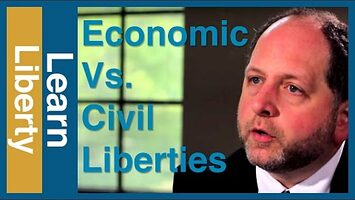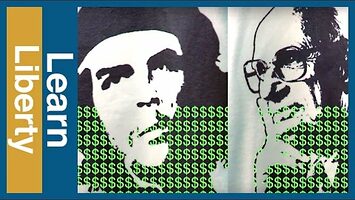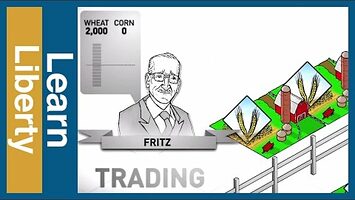Trade
Encyclopedia
Free trade means the exchange of goods and services across international borders, unhindered by government tariffs, quotas, or other restrictions. Since the publication of The Wealth of Nations by Adam Smith in 1776, the debate over free trade has been one of the major battlegrounds in the broader controversy about economic freedom. Free trade is an essential component of globalization, which includes not only trade, but the international flow of capital and people and the resulting integration of national economies with each other.
Free trade has been a central tenet of the libertarian, or classical liberal, philosophy for centuries. The same philosophical and economic arguments for the freedom of exchange within a national economy apply equally to exchange across international borders. According to libertarian principles, workers should be free to voluntarily exchange the fruits of their labors with others for mutual benefit, whether the trading partner lives across the road or across an ocean. The increased competition occasioned by free trade can indeed result in some domestic industries losing market share and workers temporarily losing jobs, but advocates of free trade see this loss as a normal and healthy outcome of free-market competition.
Mankind has always engaged in trade. Even in the poorest societies, households have traded with one another, and rural farmers have traded with city dwellers. However, natural barriers, long distances, and government controls have hindered international trade throughout much of mankind’s history. Despite those obstacles, trade flourished in the Mediterranean basin for centuries before the rise of the Roman Empire, reaching its height in the 2nd and 3rd centuries A.D., while during the late Middle Ages, the member states of the Hanseatic League were engaged in a burgeoning trade in the Baltic and North Seas. During that same time, Venice thrived as the center of the overland spice trade from Asia. Venetian traders pioneered foreign exchange, bank loans, accounting, and letters of credit. Spices and manufactured goods were the staple of trade in the Mediterranean, whereas lumber, fish, wool, and hides were the chief commodities of trade in Northern Europe.
The voyages of discovery in the 15th and 16th centuries opened new routes among Europe, the New World of the Americas, and the markets of South and East Asia, ushering in the Mercantilist Era. The discoveries and dramatic expansion of sea-going trade were made possible by the development of three-masted ships, called carracks, which could sail more sharply into the wind and made shipping less dependent on seasonal trade winds. The leading trading nations of that era, which lasted until about 1800, were Spain and Portugal, followed by the Dutch Republic and then France and Great Britain. As trade grew, so did government intervention. According to the prevailing mercantilist ideas at the time, exports were preferable to imports because they better enabled governments to acquire and accumulate gold, the universal currency of the day. As a result, a web of national laws evolved that hindered trade in a broad range of goods, but especially manufactured items.
Against this backdrop, Adam Smith published his magisterial work, An Inquiry into the Nature and Causes of the Wealth of Nations. Smith argued, with systematic logic and illuminating examples, that a nation’s wealth is not measured by its stockpile of gold, but by the ability of its people to produce goods and services of value to others. Nations raise their productivity through the division of labor, with households, regions, and nations specializing in what they do best. Trade allowed the creation of more wealth by expanding the size of the market, thus allowing a finer division of labor among and within nations. As Smith famously observed in Book IV,
It is the maxim of every prudent master of a family, never to attempt to make at home what it will cost him more to make than to buy.… What is prudence in the conduct of every private family, can scarce be folly in that of a great kingdom. If a foreign country can supply us with a commodity cheaper than we ourselves can make it, better buy it of them with some part of the produce of our own industry, employed in a way in which we have some advantage.
The intellectual argument for free trade was fortified in 1817 when British stockbroker David Ricardo first explained the theory of “comparative advantage.” According to this theory, even if a nation’s workers can produce everything more efficiently than workers in other nations, they can still trade profitably. What matters is what those workers produce most efficiently compared with whatever else they could produce. Hence, if workers in a rich country are twice as efficient at producing shoes as workers in a poor country, but five times more efficient at producing computer chips, it is still an advantage for both nations for the rich country to specialize in computer chips and import shoes from the poor country. By specializing in their comparative advantages, each country can shift resources—capital, labor, and land— to those sectors where gains in productivity and output are greatest. The final result is that workers in both nations can increase their consumption of both goods.
The ideas of Smith and Ricardo fueled the movement in Great Britain to repeal trade barriers and embrace free trade. Reformers Richard Cobden and John Bright led a successful effort in 1846 through the Anti-Corn Law League to the repeal of Britain’s high tariffs on agricultural grains. For the rest of the 19th century, Britain engaged unilateral free trade. Cobden later joined Parliament and became an international advocate of free trade as an instrument of peace among nations.
Meanwhile, in a series of brilliant essays, French economist Frédéric Bastiat argued for free trade on the European continent. Through a combination of incisive analysis and devastating satire, Bastiat ridiculed the whole range of protectionist arguments. In “A Petition,” for example, he used the protectionists’ own logic to argue for a law requiring citizens to cover their windows during the day to protect France’s candle-making industry from unfair competition from the sun. Like Cobden, Bastiat argued that international commerce promoted peace among nations and is widely credited with the saying, “When goods cannot cross borders, armies will.”
Bastiat portrayed free trade as an essential human liberty. In an 1849 essay, “Communism and Protection,” Bastiat noted,
every citizen who has produced or acquired a product should have the option of applying it immediately to his own use or of transferring it to whoever on the face of the earth agrees to give him in exchange the object of his desires. To deprive him of this option when he has committed no act contrary to public order and good morals, and solely to satisfy the convenience of another citizen, is to legitimize an act of plunder and to violate the law of justice.
Although the benefits of free trade were soon accepted as economic orthodoxy, it was not universally practiced even during the height of the first wave of globalization in the 19th and early 20th centuries. Germany and the United States, in particular, used trade barriers to protect certain industries. But barriers to trade remained on average low compared with what they had been during the mercantilist era, and rapid industrialization, falling transportation costs due to steamships and railroads, and political stability fueled a dramatic rise in global trade and capital flows until World War I.
The global conflict from 1914 to 1918 disrupted trade and ushered in new economic controls that did not disappear when the war ended, and efforts to return to the economic policies of the more liberal prewar system were only partially successful. The Great Depression of the 1930s unleashed a vicious cycle of rising trade barriers, falling trade volume, and deepening economic misery and nationalism. The U.S. Congress and then-President Herbert Hoover compounded the crisis by enacting the Smoot–Hawley tariff in 1930, which raised tariffs dramatically on a broad swath of imports to the United States. The tariff bill did not cause the Great Depression, but it did prolong and deepen it, and it certainly did not protect domestic industry and jobs as its advocates claimed it would.
After the devastation of the Great Depression and World War II, the United States and its Western allies lowered trade barriers unilaterally and through the multilateral General Agreement on Tariffs and Trade (GATT), which 23 nations first signed in 1947. The reduction in trade barriers stimulated a dramatic rise in global trade flows and cemented peaceful ties among Western Europe, the United States, and Japan. Through engagement in the global economy, the “Tigers” of East Asia—South Korea, Taiwan, Singapore, and Hong Kong—transformed themselves from poor to rich countries. Beginning in the 1970s, Mainland China, India, Chile, Mexico, and less-developed nations lowered their previously high trade barriers, welcomed foreign investment, and dramatically increased their trade with the rest of the world. The collapse of global communism in 1989 and the growing disillusionment with protectionism as a tool of development have led to further reductions in trade barriers worldwide.
Despite more than two centuries of economic thought and empirical evidence in support of free trade, it continues to remain controversial today. Industries seeking relief from competition from abroad have been joined by environmentalists, antimarket activists, and some conservatives in opposing market-opening trade agreements. Others have argued that free trade spurs a “race to the bottom” as multinational companies seek locations where labor and regulatory costs are lowest. Supporters of free trade counter that the wealth that trade creates allows people in less-developed countries to raise their own environmental and labor standards and to reduce or eliminate child labor. They point out that most global investment flows between developed countries, where workers are more productive because of better education, capital, and infrastructure.
Today, people generally enjoy greater freedom to engage in mutually beneficial trade across international borders than they had been allowed in the past, but government controls still remain significant. Trade barriers in much of the less-developed world remain high, retarding development and restricting freedom. In rich countries, low average tariff levels are belied by stubbornly high barriers against imports of textiles, apparel, steel, and many agricultural goods, such as sugar, cotton, beef, citrus, and dairy products. So-called antidumping laws are used to impose tariffs on imports that are allegedly being sold at an unfairly low price, but in reality are being priced according to normal market conditions.
Libertarians agree on the desirability of free trade, but not always on how to achieve it. Some libertarians are skeptical of trade agreements between governments, such as the North American Free Trade Agreement, because such agreements can exclude politically sensitive sectors from liberalization or can create new bureaucracies to monitor environmental or labor standards. They see the World Trade Organization (WTO), the successor to the GATT, as an unnecessary governmental body and a potential threat to national sovereignty. Other libertarians argue that such agreements, including those negotiated through the WTO, restrain the power of governments to interfere in peaceful commerce, and that any flaws are usually outweighed by the trade liberalization they achieve. Debate also continues on whether trade promotes peace among nations, as Richard Cobden and others believed. A decline in international wars in recent decades, along with rising globalization, appears to support the connection, although some economists challenge whether there is any significant correlation.
Despite the political controversy it generates, free trade has become widely accepted by economists as the best trade policy for promoting a nation’s prosperity. It is a genuine libertarian idea that has gained widespread acceptance in theory, if not in practice.
Further Readings
Bastiat, Frédéric. Economic Sophisms and Selected Essays on Political Economy. Princeton, NJ: Van Nostrand, 1964.
Bhagwati, Jagdish. In Defense of Globalization. New York: Oxford University Press, 2004.
Hazlitt, Henry. Economics in One Lesson. San Francisco: Laissez Faire Books, 1996.
Hinde, Wendy. Richard Cobden: A Victorian Outsider. New Haven, CT: Yale University Press, 1987.
Irwin, Douglas. Against the Tide: An Intellectual History of Free Trade. Princeton NJ: Princeton University Press, 1996.
———. Free Trade under Fire. 2nd ed. Princeton, NJ: Princeton University Press, 2005.
Larsson, Tomas. The Race to the Top: The Real Story of Globalization. Washington, DC: Cato Institute, 2001.
Lindsey, Brink. Against the Dead Hand: The Uncertain Struggle for Global Capitalism. New York: Wiley, 2002.
Norberg, Johan. In Defense of Global Capitalism. Washington, DC: Cato Institute, 2003.
Sally, Razeen. Classical Liberalism and International Economic Order: Studies in Theory and Intellectual History. London: Routledge, 1998.
Smith, Adam. An Inquiry into the Nature and Causes of the Wealth of Nations. New York: Modern Library, 1982 [1776].
Wolf, Martin. Why Globalization Works. New Haven, CT: Yale University Press, 2004.












